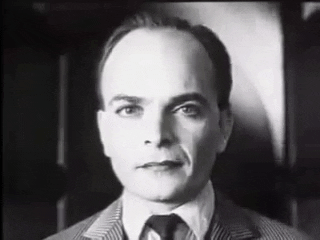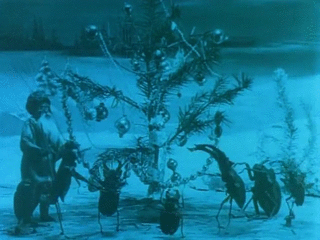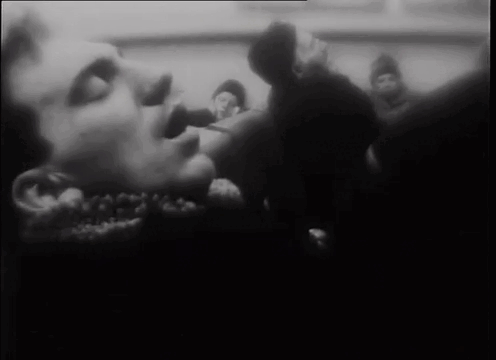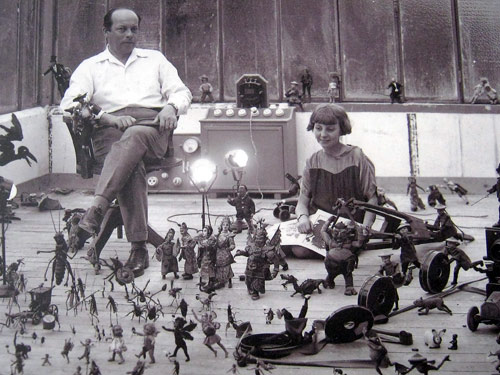“That's all the people we've got now. We'll get there somehow.” Хлебный день [Khlebnyy den / Bread Day] (Sergei Dvortsevoy, 1998)
Aug
10
green

The old folks pushing the cart past the hamlet's name sign. With thick brush strokes, almost too much for the small rectangle, it reads TOWNSHIP NR. 3. DP: Alisher Khamidkhodzhaev.
Green: a building or structure*
Where the old folks' hands push the cart, the green's worn off. That doesn't change anything about its importance. A lifeline, bread, is delivered once a week and with delivered, it means that the carriage is left on the rails, several kilometers away from Zhikharevo, or Township Nr. 3, which in its turn is about 80 km away from Saint Petersburg. It takes the seniors about two hours to get the wagon to their hamlet. We get to witness ten minutes or so. It lasts a lifetime.
As of 2002, only three people lived in Zhikharevo. I wonder how the wain comes home now.
* the Bales 2025 Film Challenge for August is not date-related but lists, for the most part, the colours of the rainbow.
russia
“When we began to compare the typically American, typically European, and typically Russian films, we noticed that they were distinctly different from one another in their construction. We noticed that in a particular sequence of a Russian film there were, say, ten to fifteen splices, ten to fifteen different set-ups. In the European film there might be twenty to thirty such set-ups (one must not forget that this description pertains to the year 1916), while in the American film there would be from eighty, sometimes upward to a hundred, separate shots. The American films took first place in eliciting reactions from the audience; European films took second; and the Russian films, third. We became particularly intrigued by this, but in the beginning we did not understand it.” Эффект Кулешова [Kuleshov Effect] (Lev Kuleshov, 1918)
Aug
5

A closeup of a man, followed by a medium shot of a child in a coffin, then back to the man. Can you see how his expression changes? (via). DP: to be determined.
Celebrating Dia de Los Muertos [on November 1 and 2, of course]: a cemetery, coffin, or dead person*
– Lev Kuleshov, The Principles of Montage, from The Practice of Film Direction (pp. 183-195) (source)
Director Lev Kuleshov explains what happens when a scene is followed by a reaction shot. Depending on the preceding image, the viewer projects an emotion onto the performer's facial expression. In his most famous montage, made up of existing footage – because property is theft, we see matinee idol Ivan Mosjoukine “react” to a bowl of soup, a little girl in a coffin, and a woman sprawled out on a divan.
* the Bales 2025 Film Challenge for August is not date-related but lists, for the most part, the colours of the rainbow.
Среда [Sreda / Wednesday / Wednesday 19.7.1961] (Viktor Kosakovskiy, 1979)
Jul
19
Wed

Adult twins who, like director Kosakovskiy, were born on Wednesday 19, 1961. DP: Victor Kossakovsky.
“This future of yours Shelmerdine, when it's gonna begin? Today? Or, is it always tomorrow?”Orlando (Sally Potter, 1992)
Jan
24
Billy Zane's birthday

Orlando (Tilda Swinton) and Shelmerdine (Billy Zane) in intimate embrace. DPs: Aleksey Rodionov & Andrew Speller.
A [favourite] Billy Zane film for his birthday (1966).
– Orlando
As ordered by Queen Elizabeth I (Quentin Crisp), nobleman Orlando remains young and traverses exotic scenery, civilisations, time, and gender.
Рождество обитателей леса (ca 1912)
Various beetles and a grasshopper rejoice around the Christmas tree materialised by Old Man Frost.

December 25: a Santa for #Christmas
Pождество обитателей леса [Rozhdestvo obitateley lesa / The Insects' Christmas] (Wladyslaw Starewicz, ca 1912)
Father Christmas makes a Christmas tree for the people of the forest.
Дед Мороз (Ded Moroz, or Old Man Frost) is the Slavic version of Saint Nicholas or Santa Claus. An ornament depicting the old grey climbs down a child's (or doll's) Christmas tree and sets off to the forest where he plants his magic staff to create a Christmas feast for the woodland animals.
The word “animation” means “a bestowing of life“. Like his ancestor in the arts Bernard Palissy and the ancient winter solstice celebration of the return of light that long ago spawned Christmas, Wladyslaw Starewicz's Insects' Christmas breathes life into real but inanimate beetles, dragonflies, and frogs. The illusion is complete as you effortlessly forget they are painstakingly animated.
From me to you, a little Christmas treat
Director Wladyslaw Starewicz and his daughter Irina (Irene), surrounded by several of his tiny actors. Irina, writer and director in her own right, starred in her father's WW1 short “Liliya Belgii” [“The Lily of Belgium”] (1915).
#Bales2023FilmChallenge #WladyslawStarewicz #Russia #fantasy #animation #ShortFilm #Christmas #holidays #StopMotion #insects #animals #1910s ★★★★☆
Полустанок [Polustanok / The Halt] (Sergey Loznitsa, 2000)
Mar
17
World Sleep Day

People leaning back on the train station's benches, fast asleep. DP: Pavel Kostomarov.
In a small train station's waiting room, people #sleep. #Trains in the distance rumble along. #Snow covers footprints crossing nearby tracks and the wooden shed where travellers, strangers, huddle together in their shared fate. Pavel Kostomarov's cinematography and Sergey Loznitsa's direction capture the silence.
